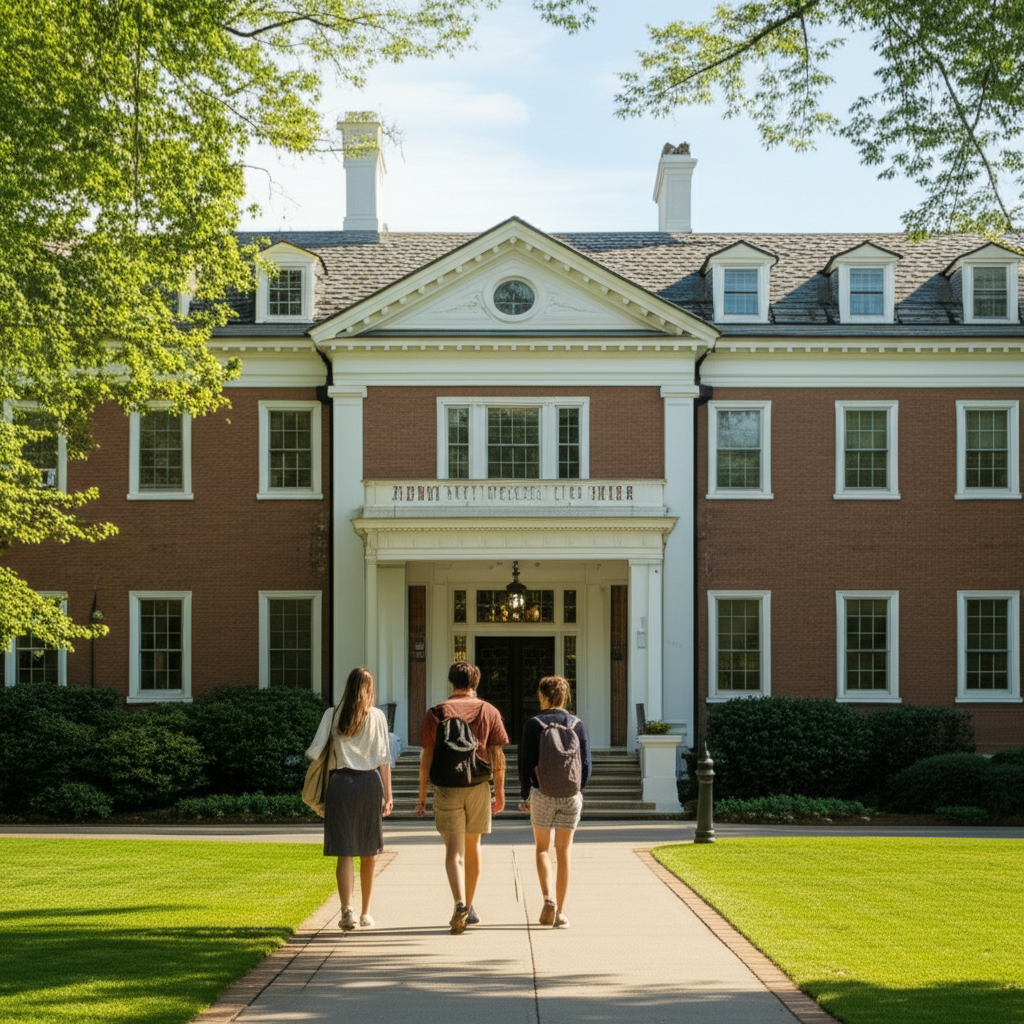What is the hardest private school to get into?
Determining the absolute hardest private school to get into is complex, as admission rates fluctuate yearly and depend on applicant pools. However, highly selective boarding schools and elite day schools often have acceptance rates below 10%, making them exceptionally difficult to gain admission to.
Getting into top private schools is a question many families ponder. It often feels like navigating a maze, with confusing requirements and fiercely competitive spots. Many parents and students wonder which schools stand out as the most selective. Understanding what makes a school “hardest to get into” can help you prepare better and set realistic goals. This guide will break down the factors that contribute to a school’s admission difficulty and explore some of the most sought-after institutions, providing a clear path to understanding the admissions landscape.
Understanding Admission Difficulty in Private Schools
When we talk about the “hardest private school to get into,” we’re really discussing schools with extremely low acceptance rates. These rates are a direct reflection of how many students apply compared to how many spots are available. Think of it like a popular concert with only a few hundred tickets for thousands of fans – the demand is immense, making it very tough to secure a ticket.
Several factors contribute to a private school’s admission difficulty:
- Academic Reputation: Schools with a long-standing history of academic excellence, strong college placement records, and renowned faculty naturally attract more applicants.
- Selectivity: The sheer number of students applying versus the limited number of available seats is the primary driver of low acceptance rates.
- Program Offerings: Unique or highly specialized programs (e.g., STEM focus, arts conservatory, specific athletic training) can draw a concentrated pool of highly motivated and talented applicants.
- Location and Prestige: Schools located in desirable areas or those with a strong global reputation often receive a higher volume of applications.
- Alumni Network and Endowments: Schools with powerful alumni networks and substantial financial resources can offer exceptional opportunities, further increasing their appeal.
The Role of Acceptance Rates
Acceptance rates are the most common metric used to gauge a school’s selectivity. For instance, an acceptance rate of 5% means that for every 100 students who apply, only 5 are offered admission. These numbers can be eye-opening and underscore the competitive nature of admission to many private schools.
It’s important to remember that acceptance rates are not static. They can change from year to year based on the applicant pool’s size and the school’s enrollment goals. However, consistently low acceptance rates are a strong indicator of a school’s difficulty to enter.
Beyond the Numbers: Holistic Review
While acceptance rates provide a quantitative measure, private school admissions typically involve a holistic review process. This means admissions committees look at more than just grades and test scores. They consider a wide range of factors to understand each applicant as a whole person.
Key elements of a holistic review often include:
- Academic Achievements: This encompasses grades, standardized test scores (if submitted), the rigor of coursework, and any academic awards or honors.
- Extracurricular Activities: Participation and leadership in sports, arts, clubs, community service, and other activities demonstrate a student’s interests, passions, and commitment.
- Essays and Personal Statements: These provide insight into a student’s personality, writing ability, critical thinking skills, and aspirations.
- Recommendations: Letters from teachers and counselors offer perspectives on a student’s character, academic performance, and potential contributions to the school community.
- Interviews: Interviews allow admissions officers to assess a student’s communication skills, maturity, and fit with the school’s culture and values.
- Character and Personal Qualities: Attributes like resilience, integrity, curiosity, leadership potential, and a collaborative spirit are highly valued.
A school might have a low acceptance rate, but a student who demonstrates a strong alignment with the school’s mission and values, coupled with exceptional personal qualities, can still stand out.
Identifying Highly Selective Private Schools

Pinpointing the single “hardest” private school is challenging due to variations in data and the dynamic nature of admissions. However, certain institutions consistently appear at the top of lists for their extremely low acceptance rates and rigorous academic standards. These are often boarding schools or elite day schools with national and international reputations.
Top Tier Boarding Schools
Boarding schools, by their nature, often have a more focused and competitive admissions process, especially those with a long history and prestigious alumni networks. They aim to build a diverse and talented residential community.
Here are some examples of boarding schools frequently cited for their high selectivity:
- Exeter (Phillips Exeter Academy), New Hampshire: Known for its Harkness method of teaching, Exeter emphasizes student-led discussions and collaborative learning. Its acceptance rate is consistently among the lowest in the nation, often in the single digits.
- Andover (Phillips Academy), Massachusetts: Similar to Exeter, Andover is renowned for its rigorous academics, strong arts and athletics programs, and its own version of the Harkness method. It also boasts a very low acceptance rate.
- Choate Rosemary Hall, Connecticut: This boarding school is recognized for its innovative curriculum, strong emphasis on community, and excellent college placement. It attracts a large number of applicants for its limited spots.
- St. Paul’s School, New Hampshire: St. Paul’s is celebrated for its beautiful campus, traditional yet progressive educational approach, and its commitment to developing well-rounded individuals.
- Hotchkiss School, Connecticut: Known for its beautiful rural campus and strong academic and extracurricular programs, Hotchkiss is another highly selective boarding school.
Elite Day Schools
While boarding schools often grab headlines for their selectivity, many top-tier day schools also have incredibly competitive admissions processes, particularly in major metropolitan areas.
Examples of highly selective day schools include:
- The Spence School, New York City: A leading all-girls school in Manhattan, Spence is known for its rigorous academics and strong focus on empowering young women.
- Trinity School, New York City: Another prestigious New York City institution, Trinity School offers a comprehensive education with a strong emphasis on character development.
- The Brearley School, New York City: Also an all-girls school in NYC, Brearley is highly selective and known for its demanding curriculum and exceptional college matriculation.
- Sidwell Friends School, Washington D.C.: Famous for educating children of prominent figures, Sidwell Friends is a co-educational Quaker school with a strong academic reputation and a highly competitive admissions process.
- Harvard-Westlake School, Los Angeles: Located in Southern California, this co-educational school is known for its strong academic programs and attracts many talented students, particularly those interested in the arts and entertainment industry.
Factors Contributing to Extreme Selectivity
These schools often share common traits that contribute to their “hardest to get into” status:
- Exceptional Faculty: Highly qualified and dedicated teachers who are experts in their fields.
- Advanced Curriculum: Rigorous academic programs, including AP, IB, or their own challenging coursework.
- State-of-the-Art Facilities: Modern libraries, science labs, arts centers, and athletic complexes.
- Strong College Counseling: Robust support for students navigating the college application process, leading to impressive matriculation lists at top universities.
- Vibrant Community: A palpable sense of shared purpose, intellectual curiosity, and diverse perspectives among students and faculty.
- Low Student-to-Teacher Ratios: Allowing for more individualized attention and personalized learning experiences.
For a deeper dive into the specifics of admissions for some of these schools, you can often find information on their official websites, such as Phillips Exeter Academy’s admissions page: Phillips Exeter Academy Admissions.
The Admissions Process: What to Expect
Gaining admission to these highly selective schools requires a thorough understanding of their application process and a strategic approach to preparation. It’s a multi-faceted journey that begins long before the application deadline.
Key Application Components
Most selective private schools require a comprehensive application that typically includes:
| Application Component | Description | Importance |
|---|---|---|
| Application Form | The standard online or paper form collecting personal, family, and academic information. | Essential for basic eligibility. |
| Academic Transcripts | Official records of grades from previous schools. | Crucial for assessing academic performance and rigor of coursework. |
| Standardized Tests | SSAT, ISEE, or other accepted tests (may be optional for some schools). | Provides a benchmark for academic ability, though increasingly schools are test-optional. |
| Essays/Personal Statements | Student-written pieces reflecting on experiences, goals, or specific prompts. | Allows students to showcase personality, writing skills, and unique voice. |
| Recommendations | Letters from teachers, counselors, or mentors. | Offers external validation of a student’s character, academic effort, and potential. |
| Interviews | One-on-one or group conversations with admissions officers, faculty, or current students. | Assesses communication skills, maturity, and “fit” with the school community. |
| Extracurricular/Activity List | A summary of involvement in sports, arts, clubs, volunteer work, etc. | Demonstrates interests, leadership, and time management skills. |
| Parent/Guardian Statement | Sometimes required to understand family support and expectations. | Provides context about the student’s home environment and family’s role. |
Preparing Your Application
Success in the admissions process for highly selective schools hinges on careful preparation and showcasing your strengths effectively.
1. Academic Excellence
Focus on achieving the best possible grades in challenging courses. If standardized tests are required or recommended, dedicate time to studying and practicing. Many resources are available online and through test prep services.
2. Extracurricular Engagement
Pursue activities you are genuinely passionate about. Deep involvement and leadership roles are often more impactful than superficial participation in many activities. Quality over quantity is key.
3. Crafting Compelling Essays
Start early and brainstorm ideas that highlight your unique personality, experiences, and growth. Be authentic, specific, and thoughtful. Proofread meticulously!
4. Securing Strong Recommendations
Build good relationships with your teachers and counselors. Ask them well in advance and provide them with information about your achievements and goals to help them write a strong letter.
5. Excelling in the Interview
Prepare by researching the school, understanding its mission, and practicing answering common interview questions. Be yourself, be enthusiastic, and ask thoughtful questions.
6. Understanding the School’s Mission and Values
Research the school thoroughly. What is its philosophy? What kind of students does it seek to attract? Tailor your application to demonstrate how you align with their specific community and goals.
Navigating Test-Optional Policies
A growing number of private schools have adopted test-optional or test-blind policies. If a school is test-optional, you have the choice to submit your standardized test scores.
- If you have strong scores: Submitting them can reinforce your academic profile.
- If your scores are not as strong as your grades or you feel they don’t represent you accurately: You can choose not to submit them and rely on other parts of your application to shine.
Always check the specific school’s policy and consider what best represents your academic capabilities.
Factors Beyond Acceptance Rate

While acceptance rate is a significant indicator, it’s not the only measure of a school’s difficulty or suitability. Understanding these nuances can lead to more informed decisions.
1. Financial Aid and Affordability
Many highly selective private schools offer robust financial aid programs, making them accessible to a wider range of students. However, the “sticker price” can be very high, and the competition for financial aid can also be intense. Some schools may have a higher percentage of students receiving aid, which can indirectly influence the applicant pool’s diversity and the overall admissions challenge.
2. Geographic Diversity and International Applicants
Top boarding schools, in particular, often strive for geographic and cultural diversity. This means they actively recruit students from various regions and countries. For international students, the application process can involve additional steps, such as English proficiency tests (TOEFL, IELTS) and different credential evaluations, adding another layer of complexity.
3. Specific Program Entry
Some schools may have separate admissions tracks or particularly competitive entry for specialized programs, such as a performing arts conservatory or a specialized STEM track. The difficulty of getting into these specific programs can exceed the overall school acceptance rate.
4. The “Fit” Factor
A school might have a low acceptance rate, but if an applicant doesn’t “fit” the school’s culture, community, or specific needs, admission may still be unlikely. Conversely, a student who deeply aligns with a school’s values and mission might have a better chance, even at a highly selective institution. This highlights the importance of thorough school research.
Preparing for a Competitive Admissions Cycle
The journey to admission at the most selective private schools is a marathon, not a sprint. It requires long-term planning and consistent effort.
Long-Term Preparation Strategies
- Start Early: For middle school admissions, begin researching and visiting schools in elementary school. For high school, the process often starts in 7th or 8th grade.
- Build a Strong Academic Foundation: Focus on consistent performance in challenging coursework from the earliest grades.
- Cultivate Interests: Develop passions in extracurricular activities. Seek depth and leadership opportunities.
- Develop Strong Study Habits: Good study skills will serve you well throughout the admissions process and beyond.
- Read Widely: This improves vocabulary, comprehension, and critical thinking, which are vital for essays and interviews.
Researching and Visiting Schools
Visiting campuses, attending virtual information sessions, and speaking with current students or alumni can provide invaluable insights into a school’s atmosphere and culture. This research helps you determine which schools are the best fit for your academic and personal goals.
Understanding Different School Types
The “hardest” school might also depend on the type of institution you’re considering:
| School Type | Typical Characteristics | Admission Considerations |
|---|---|---|
| Elite Boarding Schools | Residential, rigorous academics, strong extracurriculars, national/international student body. | Highly competitive, holistic review, emphasis on community contribution. |
| Top Day Schools | Non-residential, often in urban/suburban areas, strong academics, diverse programs. | Very competitive, especially in major cities, holistic review. |
| Specialized Schools (e.g., Arts, STEM) | Focus on a specific discipline, often with portfolio or audition requirements. | Extremely competitive within their niche, specific talent/aptitude assessment. |
Frequently Asked Questions (FAQ)
Q1: Is there one single private school that is definitively the hardest to get into?
No, it’s not possible to definitively name one single “hardest” private school. Admission rates fluctuate annually based on the applicant pool and enrollment goals. However, schools like Phillips Exeter Academy and Phillips Academy Andover consistently have among the lowest acceptance rates, often in the single digits, making them exceptionally difficult to gain admission to.
Q2: What does a “low acceptance rate” really mean for my chances?
A low acceptance rate, typically below 10%, signifies that a school is highly selective. It means there are many more qualified applicants than available spots. While it indicates intense competition, it doesn’t mean admission is impossible. Your application must stand out through a combination of academic achievement, extracurricular involvement, personal essays, recommendations, and demonstrating a strong fit with the school’s values.
Q3: Should I still apply to schools with very low acceptance rates if my profile isn’t perfect?
Yes, it’s often worthwhile to apply to schools that are a reach, provided you also apply to a balanced list of “target” and “likely” schools. Schools use holistic review, meaning they consider many factors beyond just grades and test scores. If your passion for the school is evident, you have strong personal qualities, and your application thoughtfully addresses the school’s mission, you still have a chance.
Q4: How important are standardized tests like the SSAT or ISEE if a school is test-optional?
If a school is test-optional, it means you have the choice to submit your scores. If you have taken the test and achieved scores that you believe strongly support your application and reflect your academic abilities, submitting them can be beneficial. If your scores are not as strong, or if you feel other parts of your application better represent your capabilities, you can choose not to submit them. Always check the school’s specific policy and guidance.
Q5: What is the most important factor in a private school application?
There isn’t one single “most important” factor, as admissions committees use a holistic review. However, demonstrating a genuine “fit” with the school’s mission, values, and community is crucial. This is often conveyed through thoughtful essays, strong recommendations that speak to character and potential, and interview performance, alongside solid academic credentials and meaningful extracurricular involvement.
Q6: How can I make my application stand out from thousands of others?
To make your application stand out, focus on authenticity and specificity. Let your unique personality shine through in your essays. Highlight leadership and deep engagement in extracurriculars rather than just participation. Clearly articulate why you are a good fit for that specific school, referencing its programs, values, or community in your application materials. Strong, personalized recommendations also make a significant difference.
Conclusion
The question of “what is the hardest private school to get into” points to a group of institutions that demand exceptional academic performance, a compelling personal narrative, and a demonstrated fit with their unique communities. Schools like Phillips Exeter Academy and Phillips Academy Andover are frequently cited due to their consistently low acceptance rates, often in the single digits. However, the difficulty of admission is not solely defined by a number; it encompasses a rigorous holistic review process that evaluates a student’s character, passions, and potential contributions.
Preparing for admission to these elite schools requires a long-term commitment to academic excellence, deep engagement in extracurricular activities, and thoughtful presentation of oneself through essays and interviews. Understanding the nuances of the admissions process, researching schools thoroughly, and presenting an authentic and well-crafted application are key steps. While the competition is undeniably fierce, focusing on your strengths and finding schools that align with your personal and academic goals will lead to a more successful and fulfilling application journey.

